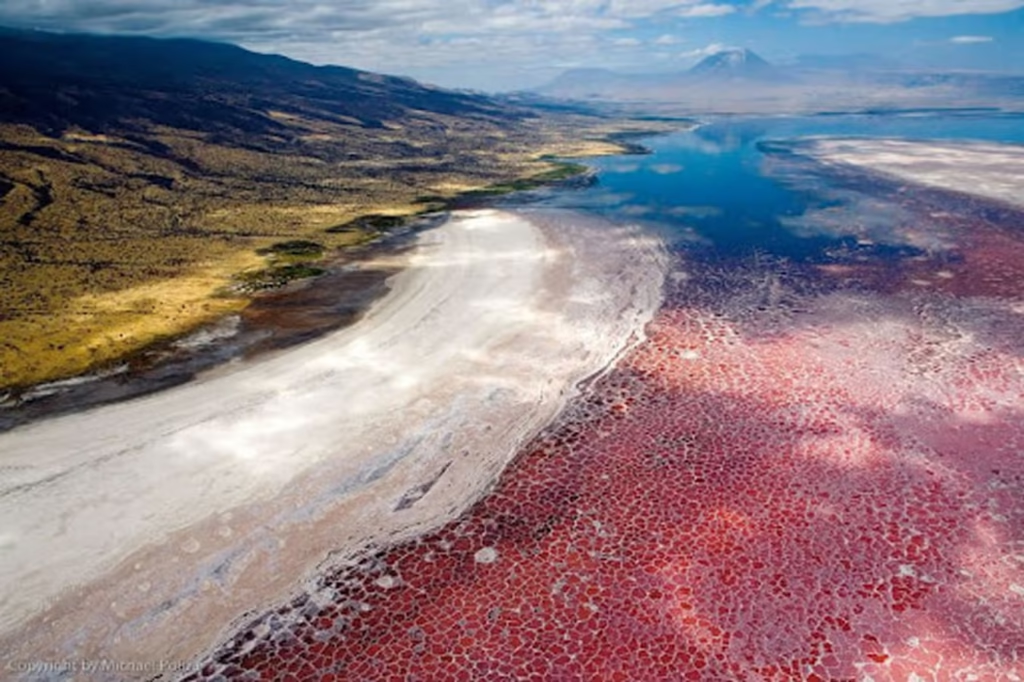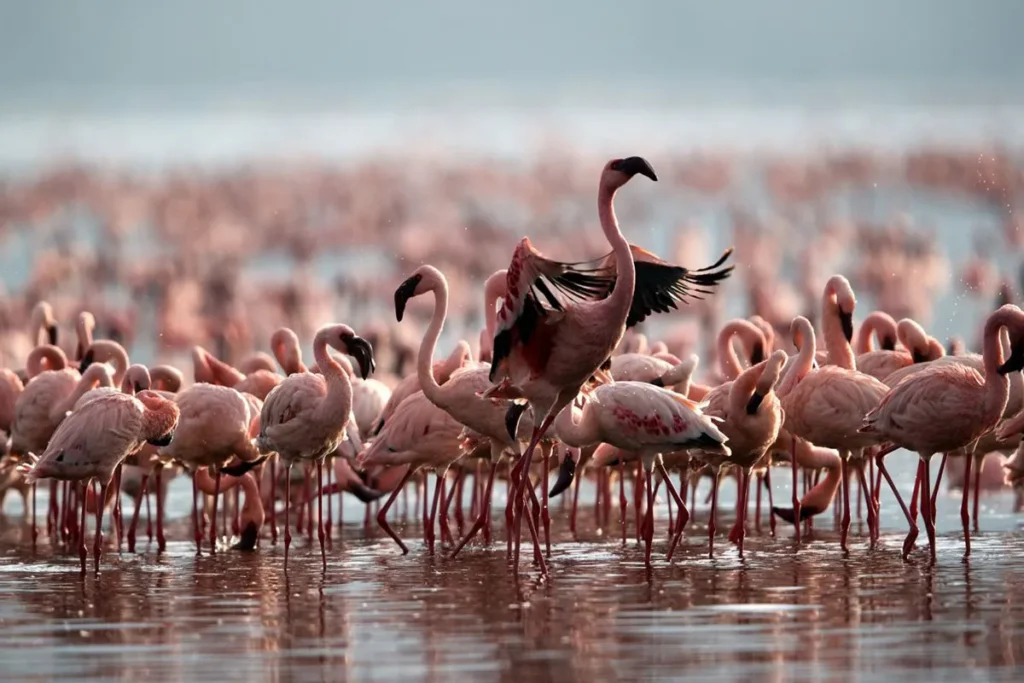Lake Natron : Facts, location, Things to do
Lake Natron is a saline or alkaline lake situated in the North Ngorongoro District of the Arusha area in Tanzania, bordering Kenya to the south. The lake has a surface elevation of 600 meters and is fed by the Ewaso Nyiro River, which originates from central Kenya and emerges from mineral-rich hot springs. The lake is quite shallow, with a depth of less than three meters, which fluctuates according to the water level. The lake has a maximum length of 57 kilometers and a width of 22 kilometers.The area surrounding the lake experiences inconsistent seasonal precipitation, with the rainy season occurring from December to May, yielding an annual total of approximately 800 millimeters of rainfall. The region experiences extreme heat, with temperatures often exceeding 40°C, equivalent to 104°F.
Lake Natron exhibits a strong alkalinity with a pH above 12. The substrate encircling the lake consists of alkaline trachyte, predominantly sodium-rich, deposited during the Pleistocene epoch. Information Regarding Lake Natron. The lavas have elevated quantities of carbonate but are deficient in calcium and magnesium. This has caused the lake to concentrate into a caustic alkaline brine. The lake undergoes significant evaporation over time, resulting in elevated concentrations of salt and other minerals, distinguishing it from other saline lakes such as the Dead Sea and Utah’s Great Salt Lake. This is due to its elevated concentration of Natron, a compound including Sodium carbonate and baking soda in its water. Lake Natron lacks an outlet, with water exiting solely via evaporation. As evaporation occurs throughout the dry season, the lake’s salinity escalates, attracting halophilic bacteria that begin to flourish. These halophilic creatures encompass cyanobacteria that synthesize their nourishment through photosynthesis, akin to plants.

This elucidates the red accessory pigment of the photosynthetic process, which enables cyanobacteria to generate the rich reds and oranges observed in the open water and along the beaches of Lake Natron. The lake appears red or pink due to the coloration of the alkali salt crust on its surface, produced by the halophilic microorganisms residing there. The lake’s edges have salt marshes and freshwater wetlands that sustain diverse plant species. Information Regarding Lake Natron Most creatures find the elevated temperatures near the lake, occasionally reaching 60°C, and the lake’s high salinity, uninhabitable. The lake hosts indigenous algae, insects, and birds, while fish thrive in the somewhat less saline areas along its shoreline.
The lake is renowned as the nesting ground for around 2.5 million lesser flamingos in East Africa. The Flamingos, the largest flock in East Africa, congregate along salty lakes to feed on blue-green algae containing red colors. Flamingos consider Lake Natron secure for nesting and breeding due of its caustic environment, which serves as a natural deterrent to predators. The Greater flamingos, another species of flamingo, also reproduce on the mud flats within the lake. Two endemic fish species can thrive in the less saline areas along the lake’s edge. The alkaline Tilapia and Ndalalani flourish near the water’s borders and in the hot springs inlets. An alcalica is present in the Lake, however it is not an endemic species.

Lake Natron is considered perilous due to its elevated concentration of cyanobacteria present in its waters. This substance releases a toxin that can harm the cells, neurological systems, and livers of most animals who ingest it. The majority of animals that have ingested water from Lake Natron have perished.
Numerous inquiries have emerged on the consequences of human beings swimming in Lake Natron, driven by the curiosity of individuals eager to investigate the lake’s enigma. It is asserted that if one were to drown or have their body disposed of in Lake Natron, the elevated salinity of the water would inhibit the decomposition process, resulting in the body being preserved akin to a specimen in brine. The lake water exhibits a high pH level, occasionally exceeding 10.5, rendering it caustic enough to cause burns to the skin and eyes of unadapted animals. In people, the lake is more conducive to the deceased than the living. In ancient Egypt, sodium carbonate and sodium bicarbonate were utilized in the mummification process.
Best time to visit Lake Natron
The optimal time to visit Lake Natron is dictated by the regional temperatures. The optimal period to visit Lake Natron is from late May to early November, as these months are comparatively cooler. The region surrounding the lake is excessively hot, particularly during the dry season from December to February. The optimal period for birdwatchers is from August, when flamingos commence their congregation, continuing until October.
Gelai Volcano
Gelai volcano, also known as Mount Gelai, is situated along the southern perimeter of Lake Natron in the East African Rift Valley. It rises to an elevation of 2,942 meters, or 9,652 feet, situated in the Longido District of Arusha, Tanzania. The volcano is located in the Crater Highlands region. It is the third most significant peak in the Arusha Region and the thirteenth highest peak overall in the region.
The Gelai volcanic activity dates back to under one million years ago. The region surrounding the Gelai volcano saw seismic activity throughout the summer of 2007. On the southern slope of the Gelai volcano, a crack has created a narrow dike with a depth of around 4000 meters. The Gelai volcano is situated in a game-controlled zone that stretches eastward to the Longido District in the Arusha region. This has led to an increase in the animal population in the area, attributable to anti-poaching initiatives.
